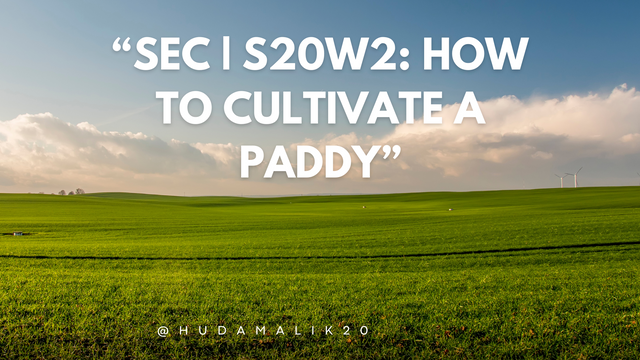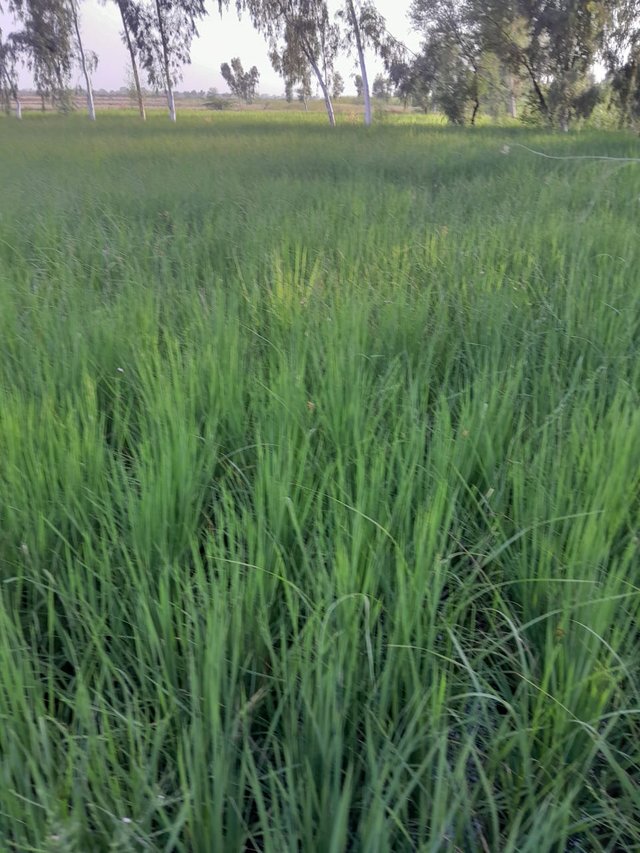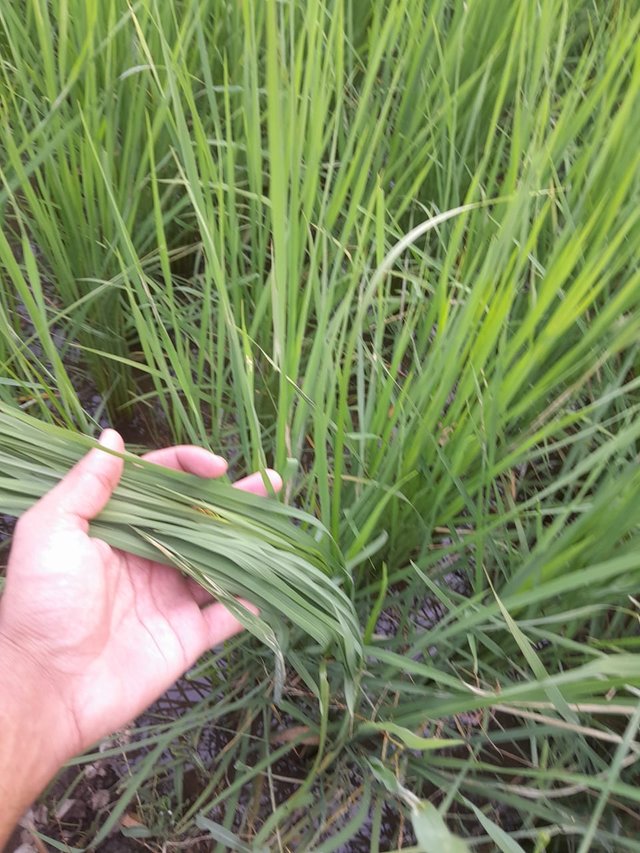I’m @hudamalik20 from Pakistan, and I’m excited to take part in the contest “SEC | S20W2: How to Cultivate a Paddy” organized by @mainuna. In this post, I will share a little understanding about rice cultivation in our area.
Our family has been farming for generations, and we take pride in growing different crops on our farmhouse in Punjab, Pakistan. We cultivate wheat, rice, and various types of fodder grass for our animals. Every year, when the rice season comes, it becomes a busy and important time for farmers in our area.


What is the method of rice seedbed preparation, and what steps are taken in preparing the soil for rice cultivation?
At our farmhouse, the first thing we focus on when preparing for rice cultivation is getting the soil ready. We usually start by plowing the land, which breaks up the soil and makes it soft.
We have this traditional way of using tractors for this process, but sometimes we still rely on older methods like manual plowing, especially in smaller fields. After plowing, we level the land to ensure the water spreads evenly when we flood the field.

Once the soil is ready, we focus on creating a seedbed. This is a small section of the field where we grow the rice seedlings. We take the rice seeds that have been soaked in water for about a day or two to help them germinate faster.
Then, they spread them carefully over the prepared soil. At this stage, the field is flooded with water, but not too much, just enough to keep the soil moist. In a few days, tiny green seedlings start to appear, and this sight always fills us with excitement and hope for the upcoming harvest.
Before sowing the seeds, we also make sure to remove any weeds and unwanted plants. Weeds can compete with rice for nutrients and water, so we take care to clear the seedbed of any unwanted growth. The land is left to rest for a while, and the seeds grow into healthy seedlings, ready for transplantation.
What is the importance of planting rice seeds at the right time?
Timing is crucial when it comes to planting rice. We usually wait for the right season, which in our region starts just after the first rainfalls. I’ve learned from my family that planting at the right time can make a huge difference in the overall yield of the rice.
If we plant too early, before the rains arrive, the soil is too dry and the seeds won’t germinate properly. And also , planting too late means the crops might not have enough time to grow before the weather changes again.
At our farmhouse, we closely watch the weather patterns. We’ve learned from experience that even a slight delay or rush can impact the harvest. That’s why we always aim to plant right at the start of the rice season, usually in late spring or early summer. This way, the rice plants get the best possible start and have enough time to mature before the colder months arrive.
How is regular irrigation and fertilizer applied after sowing rice seeds?
Once the seedlings are ready, they are transplanted into the main field. This is when water management becomes even more important. Rice needs to grow in flooded conditions, so we make sure the field is always covered with a thin layer of water.
Maintaining this balance is tricky yaa too much water can drown the plants, while too little can dry them out. We irrigate the fields regularly, especially during the hot summer months.

Fertilization is another key part of the process. Right after transplanting the rice seedlings, we apply the first round of fertilizer. In our case,my father use a mix of organic and chemical fertilizers, depending on the condition of the soil as they are provided by our government..
The fertilizers provide essential nutrients like nitrogen, which helps the rice plantss grow taller and produce more grainss. Later in the growing season if needed, my father apply additional fertilizer to ensure the plants stay strong and healthy.
What are the major pests and diseases of rice crops, and how can they be controlled?
Like any crop, rice is vulnerable to pests and diseases. At our farmhouse, we’ve had to deal with all kinds of issues, from insects to fungal infections. The most common pest we face is the rice stem borer, which can destroy the rice plants by boring into the stems. To control these pests, we sometimes use pest control methods, like neem oil and chemical sprays or we plant pest resistant varieties of rice.

Diseases like rice blast or bacterial leaf blight can also damage the crop. These diseases are usually caused by fungi or bacteria, especially in warm and humid conditions.
We make sure to rotate our crops every few seasons and use disease resistant seeds to prevent outbreaks. It’s all about staying vigilant and addressing the problem early before it spreads.
What are the next steps after harvesting the paddy, and what are the steps to be taken to preserve the paddy?
Harvesting is the most rewarding part of the process. Once the rice plants turn golden and the grains are fully developed, we know it’s time to harvest.
We usually cut the rice plants using sickles, a traditional tool we’ve been using for years, though sometimes we use machines for larger fields.
After harvesting, we immediately start the threshing process to separate the grains from the stalks. At this stage, it’s important to dry the grains properly. We spread the harvested rice out under the sun for a few days to reduce the moisture content.
This drying step is important because if the rice grains are too moist, they can spoil during storage. We lay them out in sunlight for a few days until they are fully dry.
Once dried, we pack the rice in sacks and store it in a cool, dry place. Proper storage is essential to protect the rice from insects and moisture.
We take great care to store the rice in clean containers, ensuring that it lasts for months until it’s either sold or used by our family.
That's it from today's blog I hope you will like it. With best wishes ❤️. Now I like to invite @tammanna, @neelofar and @abdul-rakib to participate in this amazing contest.
Thanks alot for reading ❤️🤗 .
My introduction post

Upvoted. Thank You for sending some of your rewards to @null. It will make Steem stronger.
Downvoting a post can decrease pending rewards and make it less visible. Common reasons:
Submit
Thank you for voting for @pennsif.witness - much appreciated.
Downvoting a post can decrease pending rewards and make it less visible. Common reasons:
Submit
Observations and suggestions:
Good to hear your family is involved in agriculture. However, your farm house still follows the old method of sowing seeds and this is the best medium. It is rightly said that if there are weeds, it will affect our desired crops. This requires suppression beforehand. In Pakistan, fertilizer is given by the government through Bhuttiki? A real farmer can give good advice on fertilizer mixing. As the rice plants are golden so you can say 80% of the rice is harvested when it is ripe. You wrote beautifully.
Feedback:
Downvoting a post can decrease pending rewards and make it less visible. Common reasons:
Submit
Thank you so much for your nice review..Yes, my family still uses the old ways of farming, but we try to learn new things.
You are right, weeds can really harm the crops, so we need to control them early.
In my country Pakistan, the government gives fertilizers to some farmers at lower prices, which helps a lot.
We also ask experienced farmers for advice on how to mix fertilizers properly. I’m happy you liked my post
Downvoting a post can decrease pending rewards and make it less visible. Common reasons:
Submit
You can periodically participate in our posts to know and understand everything.
Downvoting a post can decrease pending rewards and make it less visible. Common reasons:
Submit
Downvoting a post can decrease pending rewards and make it less visible. Common reasons:
Submit
Hey @hudamalik20! 🌾 Wow, your post about rice farming is awesome! I can almost see you out there in the fields, doing a little happy dance as those seedlings pop up! 💃🌱 It sounds like you’ve got the whole rice cultivation process down to a science, and it’s great to hear how your family has been doing this for generations.
I love the part where you mentioned the importance of timing—like rice has its own schedule! 🕒 And seriously, who knew keeping a thin layer of water on the field was such a balancing act? It’s like a game of rice Tetris! 😂🎮
Those pests sound sneaky, but I’m impressed you’re using neem oil! 🌿 Talk about eco-friendly farming! And that harvesting scene with sickles? So classic! It must feel so rewarding to see all that golden rice ready to go. 🌟
Thanks for sharing your journey! Can’t wait to see more from you and your fellow farmers! Good luck in the contest! 🎉✨
Downvoting a post can decrease pending rewards and make it less visible. Common reasons:
Submit
After seeing your post, I myself became interested in learning more about rice cultivation methods. Many thanks for presenting such a wonderful post to us.
Downvoting a post can decrease pending rewards and make it less visible. Common reasons:
Submit